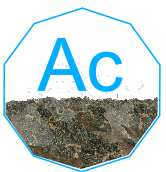Actinium

Actinium (Ac)
General Information
- Symbol: Ac
- Atomic Number: 89
- Atomic Weight: [227] u (varies due to isotopes)
- Element Category: Actinide
- Group: N/A (Actinides series)
- Period: 7
- Block: f-block
Physical Properties
- Appearance: Silvery-white metallic
- Density: 10.07 g/cm³
- Melting Point: 1050 °C (1922 °F)
- Boiling Point: 3200 °C (5792 °F)
- Phase at STP: Solid
- Electron Configuration: [Rn] 6d¹ 7s²
- Oxidation States: +3 (most common)
Chemical Properties
- Reactivity: Actinium is highly reactive with oxygen and moisture. It forms a white oxide coating when exposed to air and reacts with water to form actinium hydroxide.
- Compounds: Forms compounds such as actinium(III) oxide (Ac₂O₃) and actinium(III) chloride (AcCl₃).
Uses and Applications
- Neutron Sources: Actinium-227 is used as a neutron source.
- Cancer Treatment: Used in radiotherapy for cancer treatment, particularly in the form of Ac-225.
- Scientific Research: Actinium is used in research to study the properties of actinides and their compounds.
Occurrence and Extraction
- Natural Occurrence: Found in trace amounts in uranium and thorium ores. It is a decay product of uranium-235 and thorium-232.
- Extraction: Extracted as a byproduct from the processing of uranium and thorium ores.
Isotopes
- Stable Isotopes: Actinium has no stable isotopes.
- Radioactive Isotopes: Actinium-227 is the most stable isotope with a half-life of 21.77 years. Actinium-225 is used in medical applications.
Safety and Handling
- Hazards: Actinium is highly radioactive and poses significant health risks due to its intense radioactivity. It can cause radiation sickness and increase cancer risk.
- Precautions: Handle with extreme caution using specialized protective equipment and facilities designed to contain radioactivity. Actinium must be stored in lead containers to shield against radiation.
History
- Discovery: Discovered by Friedrich Oskar Giesel in 1899.
- Name Origin: The name “actinium” comes from the Greek word “aktinos,” meaning ray or beam, reflecting its radioactive properties.
Additional Facts
- Crystal Structure: Face-centered cubic (fcc)
- Magnetic Properties: Paramagnetic
- Thermal Conductivity: Low, about 12 W/m·K
- Electrical Resistivity: Relatively high, about 0.0007 Ω·m
Summary
Actinium is a highly radioactive actinide metal known for its use in neutron sources and cancer treatment. Found in trace amounts in uranium and thorium ores, it is extracted as a byproduct of processing these ores. Discovered in 1899, actinium’s name reflects its intense radioactivity. Due to its hazardous nature, actinium requires specialized handling and storage to prevent radiation exposure.
40 Question and Answer Pairs About Actinium
What is the atomic number of Actinium?
- 89
What is the symbol for Actinium?
- Ac
What is the atomic weight of Actinium?
- [227] u (varies due to isotopes)
In which group of the periodic table is Actinium found?
- Actinides series (no group)
What period is Actinium in?
- Period 7
What block does Actinium belong to?
- f-block
What is the melting point of Actinium?
- 1050 °C (1922 °F)
What is the boiling point of Actinium?
- 3200 °C (5792 °F)
What is the density of Actinium?
- 10.07 g/cm³
What is the electron configuration of Actinium?
- [Rn] 6d¹ 7s²
What are the common oxidation states of Actinium?
- +3
What is the appearance of Actinium?
- Silvery-white metallic
Is Actinium reactive with air?
- Yes, it forms a white oxide coating.
Name a compound of Actinium.
- Actinium(III) oxide (Ac₂O₃)
What is a common use of Actinium in medicine?
- Used in radiotherapy for cancer treatment (Ac-225).
How is Actinium used in scientific research?
- To study the properties of actinides and their compounds.
What role does Actinium play as a neutron source?
- Actinium-227 is used as a neutron source.
How is Actinium found in nature?
- In trace amounts in uranium and thorium ores.
How is Actinium extracted from ores?
- As a byproduct of processing uranium and thorium ores.
What is the most stable isotope of Actinium?
- Actinium-227
What is the half-life of Actinium-227?
- 21.77 years
What safety hazard is associated with Actinium?
- It is highly radioactive and poses significant health risks.
Who discovered Actinium?
- Friedrich Oskar Giesel
Where does the name Actinium come from?
- From the Greek word “aktinos,” meaning ray or beam.
What is the crystal structure of Actinium?
- Face-centered cubic (fcc)
Is Actinium paramagnetic or diamagnetic?
- Paramagnetic
What is the thermal conductivity of Actinium?
- About 12 W/m·K
What is the electrical resistivity of Actinium?
- About 0.0007 Ω·m
What is the primary oxidation state of Actinium?
- +3
Is Actinium found as a free element in nature?
- No, it is found in trace amounts in ores.
What is the common name of Actinium(III) chloride?
- AcCl₃
What is a major application of Actinium in medical research?
- Used in radiotherapy for cancer treatment.
How does Actinium benefit scientific research?
- It helps in studying the properties of actinides and their compounds.
What is the boiling point of Actinium in Kelvin?
- 3473 K
What group does Actinium belong to in the periodic table?
- Actinides series (no group)
What is the natural abundance of Actinium-227?
- Extremely rare, produced from uranium and thorium decay.
Can Actinium be used in high-temperature applications?
- Yes, due to its high melting and boiling points.
What is the key property that makes Actinium valuable in neutron sources?
- Its ability to emit neutrons.
How is Actinium used in radiation research?
- As a source of alpha particles and neutrons.
What precautions should be taken when handling Actinium?
- Use specialized protective equipment and facilities to contain radioactivity.






